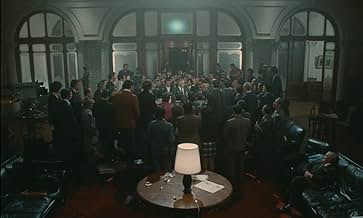Avec pour toile de fond l'interrogation d'un expert américain de la contre-insurection, le film explore la lutte entre le gouvernement uruguayen et les guérillas Tupamaro gauchistes.Avec pour toile de fond l'interrogation d'un expert américain de la contre-insurection, le film explore la lutte entre le gouvernement uruguayen et les guérillas Tupamaro gauchistes.Avec pour toile de fond l'interrogation d'un expert américain de la contre-insurection, le film explore la lutte entre le gouvernement uruguayen et les guérillas Tupamaro gauchistes.
- A remporté le prix 1 BAFTA Award
- 2 victoires et 5 nominations au total
Histoire
Le saviez-vous
- AnecdotesThis was going to be the first movie shown in the new John F. Kennedy Center for the Performing Arts in Washington, D.C. It was cancelled because the plot of the movie was judged to be inappropriate. This caused a big controversy. A Washington D.C. television station took advantage of the controversy by acquiring the broadcast rights to the film and showing it uncut after running a big advertising campaign calling it the "film banned from the Kennedy Center."
- GaffesThe International Police Academy meeting, in the flashback, takes place in 1967. But mention is made that "Technological advances have put man on the moon," which would not occur until 1969.
- Citations
Woman Senator: The frequent use of torture's intruments has been proved by the investigating comission. Remember, that this comission is composed by members of all parties present in the parliament. Your conclusions, voted by uninamity, are those. First: it has been proved that torture has become a frequent and habitual system in our country. Second: those tortures are practiced against people who even being innocent, are not submitted to a legal questioning, and against people who, submitted to a legal questioning, would have been declared innocent. Third: the main victims of those methods are the students and the union leaders. Fourth: the explanations from competent authorities, which deny the existence of those methods or declare not even knowing about them, are unacceptable, because to accept them it would mean to admit the existence of paralel organizations, autonomous and uncontrolable inside our police system. That's it, Mr. President. Gentlemen, this is what's happening in our country. All of that occurs daily in our country. All of that must end in our country. Government lords, I don't know if you were aware or not about all that. Anyway, however, you no longer have the right to govern our country.
- ConnexionsFeatured in La solitude du chanteur de fond (1974)
- Bandes originalesFantasia in G minor, BWV 542 ('Great')
(uncredited)
Written by Johann Sebastian Bach
Played by the organ at the end of the funeral near the end of the movie.
The movie is a careful presentation, an expose, on the methods and procedures of law enforcement and state police in Latin America. Furthermore, it paints the picture of a kind of American neo-imperialism or neo-colonialism.
The movie is bold, the movie is courageous, but most of all it is smart and intelligent. That being said the strength of the film is the attention of detail and it's patience. Every situation is set up and for everything, there is a payoff. Nobody does films likes this nowadays, with hundreds of extras, everything shot on location. This is one extreme form of filmmaking, where there is the least amount of shortcuts and trickery. The movie almost feels like a film version of the Grand Reportage of old. A careful mix of investigation and photojournalism. That is why you do not mind being lectured. Because the film is beautiful and has rich texture, you do not mind sitting through police violence, death squad meetings and political corruption. The text of the movie might be heavy but is balanced by the visual style.
It may be at times too smart: some of the scenes may be too wordy and whenever there is action, it is subordinate to the dialog between characters. There is a lot of expository dialog in this film, and usually this a fault, because it goes against "show don't tell". Yet, here it does not harm the argument. The way the situation is laid out in dialog between Santore and his captors is initially dry and infuriating, but as Santore perception shifts it becomes engaging. The other channel of exposition is the reporter who is merely covering the story from the outside. It almost feels as it is the most interesting part of the film given that Santore's plot is rather stale, he gets kidnapped and they talk about it for an hour. The political plot could have been the meat of the movie but unfortunately, it does not go far enough, it is treated as B-plot. However, it still functions for its political themes. My favorite scene is the sequence where all the government ministers climb out of their cars. That is cinema in its purest form. It is complete fiction but it feels real.
You can regret that the movie is not as strong narratively. There is no a lot of action, in terms of narrative. Nothing happens in the course of the movie, only minor events. The story should be the last days of Phillip Michael Santore, but it is not what the movie is about.
For that reason it does not stand at the top of Costa-Gavras' oeuvre. On the topic of government corruption and the police and fascism love story, Gravas' "Z" is the best.
- Criticalstaff
- 7 juill. 2020
- Lien permanent
Meilleurs choix
- How long is State of Siege?Propulsé par Alexa
Détails
- Date de sortie
- Pays d’origine
- Langues
- Aussi connu sous le nom de
- State of Siege
- Lieux de tournage
- sociétés de production
- Consultez plus de crédits d'entreprise sur IMDbPro
Box-office
- Brut – États-Unis et Canada
- 1 127 482 $ US
Contribuer à cette page


![Regarder Bande-annonce [OV]](https://m.media-amazon.com/images/M/MV5BNTlmZTlhYjktNThkYy00NDAyLTlkNjUtNDIwMTU3MmVhYTgyXkEyXkFqcGdeQXRyYW5zY29kZS13b3JrZmxvdw@@._V1_QL75_UX500_CR0)




























